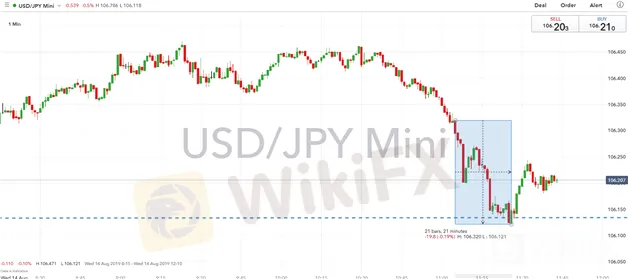简体中文
繁體中文
English
Pусский
日本語
ภาษาไทย
Tiếng Việt
Bahasa Indonesia
Español
हिन्दी
Filippiiniläinen
Français
Deutsch
Português
Türkçe
한국어
العربية
US Recession Watch - US Yield Curve Inverts, But Panic When it Steepens
Abstract:US Recession Watch - US Yield Curve Inverts, But Panic When it Steepens
US 2s10s Treasury Curve Inverts for the First Time Since 2007
The US 2s10s curve has inverted for the first time since 2007, however, this had been a long time coming given the deep inversion in the 3M-10yr curve. Alongside this, while todays inversion is seen as more symbolic, it does provide yet another reminder in regard to rising fears of a slowdown in the global economy, particularly noted in the global bond market as yields drop towards record lows (US 30yr now yielding an all-time low of 2.06%).
Why Does the US Yield Curve Inversion Matter?Market Reaction to Symbolic Inversion
In reaction to the 2s10s inversion, safe havens had benefitted with USDJPY dropping to session lows of 106.13, gold pushed towards its best levels of the day at $1508, while US equity futures headed lower, although moves have been relatively contained thus far. In turn, this increases the importance of next weeks main focus in the form of the Jackson Hole Symposium, which quite fittingly is titled the “Challenges of Monetary Policy”.
USDJPY Price Chart: 1-minute Time Frame (Intra-day)

S&P 500 Price Chart: 1-minute Time Frame (Intra-day)

Yield Curve Inversion: Predictor of Recessions
While an inversion of the US yield curve has been a reliable indicator for warning of an economic recession, predicting the past 5 recessions and almost all US recessions in the past century. The actual inversion is unlikely to cause an immediate concern given that it usually takes 20 months before a recession hits the economy.

Source: DailyFX
Panic When the Yield Curve Steepens
As mentioned above the US yield curve has been reliable in regard to predicting recessions, however it does not provide a great signal as to when a potential recession will happen. Instead, investors should really fear the yield curve steepener given that it is closer to the actual event, as such, the steepening of a yield provides the near-term signal that a slowdown has arrived. Consequently, over the past 5 recessions the steepening of the yield has happened at a time when a slowdown has been imminent.

Disclaimer:
The views in this article only represent the author's personal views, and do not constitute investment advice on this platform. This platform does not guarantee the accuracy, completeness and timeliness of the information in the article, and will not be liable for any loss caused by the use of or reliance on the information in the article.
WikiFX Broker
Latest News
How Crypto Trading Transforms FX and CFD Brokerage Industry
FCA Warns Against 10 Unlicensed or Clone Firms
CySEC Warns Against 14 Unlicensed Investment Websites
Top Currency Pairs to Watch for Profit This Week - March 31, 2025
Will natural disasters have an impact on the forex market?
Philippines Deports 29 Indonesians Linked to Online Scam Syndicate in Manila
Exposing the Top 5 Scam Brokers of March 2025: A Closer Look by WikiFX
Gold Prices Climb Again – Have Investors Seized the Opportunity?
Webull Launches SMSF Investment Platform with Zero Fees
Australian Regulator Warns of Money Laundering and Fraud Risks in Crypto ATMs
Currency Calculator







